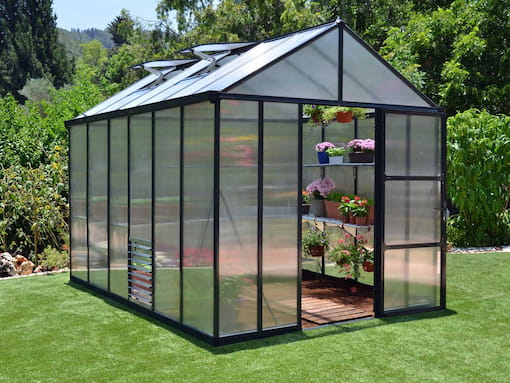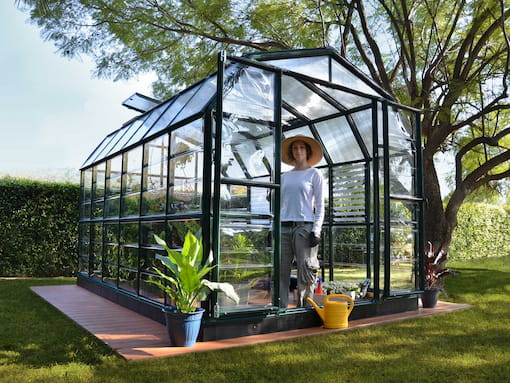
The surface of the greenhouse shines in the sun, tomatoes ripen in the intense daylight and tropical flowers thrive in the warm climate: all this is possible with a greenhouse made of both glass and plastic. But what are the differences between the two materials? Find out and learn whether glass or plastic is a better fit for your project.
Your options for greenhouse roofing
Your choice of roofing has a big impact on how well your greenhouse performs. After all, the transparent material on the roof and sidewalls should let in enough sunlight and retain enough heat inside the greenhouse. You can choose between glass and plastic roofing.
Glass covering
Glass greenhouses are an absolute classic and visually a great eye-catcher in your garden. In addition, the easy cleaning is a great advantage. Dirt can be easily removed from the smooth surface with a garden hose. At sensitive, book-endangered places this goes just as well by hand with a sponge. A surface that is easy to clean and therefore always clean allows maximum light output.
If you go by appearance and maintenance, glass is certainly the best option. However, it also brings disadvantages – beautiful, but not always practical:
One of the disadvantages is certainly the low insulation effect. Plain glass allows the sun’s rays to pass through almost unchecked. Your greenhouse can become a so-called heat boiler in the midday hours.
Tip:
In this case, shading nets can help. Stretch the nets over your glass greenhouse when the sun is too intense and regulate the indoor temperature.
The heat absorbed during the day evaporates again in the cold evening hours due to the low insulating properties of glass. Consistent climatic conditions are therefore hardly possible here. Your plants may suffer from the rapid temperature difference, because they cannot adapt so quickly.
But: If you are not aiming for a demanding year-round greenhouse, insulation may not be so important to you. In that case, a glass greenhouse is also a good option.
You have many different options when it comes to a glass greenhouse. With single glass to Nörpelglas you can freely design your roofing. All variants have their advantages and disadvantages:
Insulating glass
Insulating glass is two sheets of glass that run parallel in a frame. Between them is processed a layer of carbon dioxide. This processing technique achieves approximately the same degree of insulation as plastic, insulating glass is only significantly heavier. The material is usually used only in large and elaborate buildings, as the construction requirements are usually quite high.
Safety glass
The most commonly used glass for the construction of a greenhouse is safety glass. This is shatterproof and very stable. An obvious advantage of greenhouses made of safety glass is the enormous stability, which brings a very long durability. Even in storms, wind and hail, the material defies the weather. The panes are at least 3 mm thick and almost completely transparent with a light transmission of 85 to 95%.
Safety glass
A good alternative is Nörpel glass. Unlike blank glass (safety glass), it is textured on one side, so you can’t see through it clearly. However, sun rays can still enter and are even refracted by the structuring in such a way that optimal light conditions are created for plants.
However, the appearance of the greenhouse can lose elegance due to the structuring. Another disadvantage is that dirt can accumulate more easily due to the structuring. However, cleaning itself is easy, as with any glass.
Contents
- 1 Plastic roofing
- 2 Aluminum greenhouse
- 3 Plastic greenhouse
- 4 Frequently asked questions
- 5 Can web triple or quadruple sheets also be used for a greenhouse?
- 6 Which greenhouse is best for my garden?
- 7 What does “no drop” mean with double-skin sheets?
- 8 Does it make sense to have insurance for the glass greenhouse?
- 9 Author
Plastic roofing
In terms of breaking strength, load-bearing capacity and other safety aspects, modern plastics offer major advantages over glass.
For example, with a similar insulation value, plastic is 5 times lighter than glass on the same surface area. While twin-wall sheets with an insulation value (k-value) of 3 weigh about 4-5 kg/m², glass with a roughly equal k-value weighs about 20 kg/m². Are you wondering what this k-value is all about? The so-called k-value indicates the insulation value. The lower it is, the better the thermal insulation. However, the light transmission often suffers from a low k-value because, for example, triple-web panels are used instead of double-web panels.
The sheets of plastic enclose a layer of air, which significantly increases the insulating performance of the greenhouse. This can create long-lasting consistent temperatures and thus better growing conditions in your greenhouse. You can buy plastic panels from 4-16 mm, the rule is: the thicker, the better insulated.
With plastic roofing, in addition to the weight and insulation aspect, you should also consider the safety aspect. Plastic is much more resistant to breakage than glass. In the event of a shattered glass roof, the risk of injury is higher than with a roof made of plastic.
Plastic also scores points when it comes to processing: While glass quickly cracks or splinters if handled incorrectly, you can conveniently work on plastic with a hand-held circular saw in the garden, for example. For the processing of glass, on the other hand, it is better to get help from a professional. When choosing a material, be sure to consider its UV resistance. Material that is not UV resistant can become brittle and yellow over time. The yellowing will cause the plastic panels to become cloudy and your plants will no longer get enough sunlight.
Also, as your greenhouse roof becomes brittle, small cracks can develop over the years where dirt collects. This also affects light transmission. Basically, the more light that enters your greenhouse, the more your plants will grow. Especially in the winter months, the rather low-light months, every ray of light is important.
The light transmission depends on various factors. On the one hand, on the number of layers and the density of the bars. On the other, on the coating and the type of plastic itself.
Number of layers: Double-webbed sheets or triple-webbed sheets – the more layers, the lower the light transmission.
Density of the webs: how “close” the webs are to each other – the “closer” the webs are to each other, the lower the light transmission.
Coatings: Depending on what the plastic sheet is coated with, this can also block sunlight.
Type of plastic: With acrylic sheets and polycarbonate sheets, the light transmission of double-webbed sheets is about 80%.
Double-webbed sheets made of Plexiglas
Double web sheets are currently mostly used for the construction of greenhouses. They are made of the material polymethyl methacrylate. This plastic is known under the name of Plexiglas.
Plexiglas looks like real glass and lets through a similar amount of sunlight. The only difference is that the double-glazed sheets have a significantly higher insulation. However, Plexiglas is more susceptible to weather than glass and other plastics such as polycarbonate.
Double-webbed sheets have high transparency, do not yellow over the years, are insensitive to scratches, are very cheap to buy and are particularly light at 2-3 kg/m².
Advantages of plexiglass:
No yellowing
Better scratch resistance than polycarbonate
Higher transparency than polycarbonate
Polycarbonate twin-wall sheets
Twin-wall sheets are made of polycarbonate plastic and in and of themselves look the same as double-wall sheets. They are made in the same way, only polycarbonate has different properties than plexiglass.
If you do not clean the polycarbonate greenhouse regularly, it may turn yellow and this, in turn, may have a negative impact on the growth of your plants.
Twin-wall sheets have high weather resistance, are not sensitive to the effects of heat, can be processed as well as worked without any problems, and are quite light at 3-4 kg/m².
The following table clearly shows the advantages and disadvantages of polycarbonate:
Your options for frame material
However, plastic is not only suitable for greenhouse roofing, it has also proven itself as a frame material: The most common materials for the frame of your greenhouse are plastic on the one hand and aluminum on the other. When you buy a greenhouse, they are usually kits that do not require you to buy extra frame material.
Should you assemble your greenhouse completely by yourself, you can now learn more about the differences between the two building materials.
Aluminum greenhouse

In greenhouse kits, aluminum is the most commonly used material. Aluminum in its profile form is very resilient, making it an ideal base material for a stable frame construction. It is particularly durable and corrosion resistant, so perfect for use in a humid greenhouse. Aluminum is also a good conductor of heat.
Make sure that aluminum profiles are well insulated so that energy efficiency is high and cold bridges do not form.
Plastic greenhouse

In addition to aluminum, plastic is also an increasingly popular material for greenhouses. And for good reason: plastic is very resilient, durable, UV and color resistant, and therefore very long-lasting.
Since plastic doesn’t need to be painted or otherwise maintained, it’s perfect for anyone who wants to take care of the plants in the greenhouse rather than the greenhouse itself.
In short, it does not always have to be glass.
The classic glass greenhouse looks good and is very stable. However, it is gradually being displaced from the market by plastic greenhouses. Plastic greenhouses also have the glass look, but get rid of some of the disadvantages of real glass.
Be clear in advance about what budget you have and what requirements your greenhouse must meet.
If you do not want to dig too deep into your pocket, a greenhouse made of plastic is perfectly adequate. Due to the modern processing of plastic is visually hardly noticeable difference from real glass.
Frequently asked questions
Here you will find answers to questions we are frequently asked.
Can web triple or quadruple sheets also be used for a greenhouse?
Triple and quadruple web panels naturally increase the insulation value due to their thickness, but at the same time reduce the light transmission.
Plastic double-webbed sheets are usually quite sufficient for your greenhouse, as they already have a good insulation value and the light transmission is still around 80%.
Which greenhouse is best for my garden?
If you want to be mindful of your budget and still not compromise on workmanship, insulation value and stability, then you are very well advised to go with a plastic greenhouse.
However, if you prefer more of a classic, sturdy glass look, you’ll have to dig a little deeper into your pocket.
What does “no drop” mean with double-skin sheets?
When you water your plants in the blazing sun, they not only burn, but also give off a lot of moisture, which then collects on the greenhouse roof.
To prevent this condensation from raining uncontrollably on your plants, manufacturers have developed special “no drop” coatings. These prevent condensation from collecting on the inside of your greenhouse, thus protecting your plants from excessive wetness on the leaves. If condensation does form on the inside of the roof, it will run off the edge thanks to the coating.
When buying your greenhouse, look for the “no drop” feature.
Does it make sense to have insurance for the glass greenhouse?
To ensure that the yield of your plants is not affected by natural forces or technical errors in heating or ventilation, you can insure your greenhouse against these damages. In addition, if you have valuable plants housed in the greenhouse, insurance for your plants is advisable.
If you have taken out residential building insurance for your house against fire, storm or hail, your greenhouse is usually also covered in the additional glass insurance you have taken out. It is best to ask your insurance agent about this.

